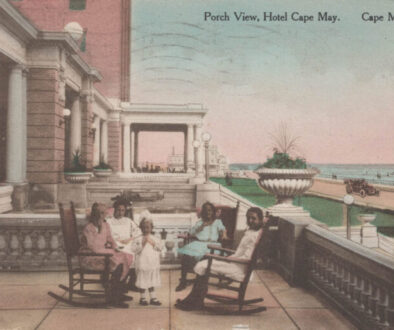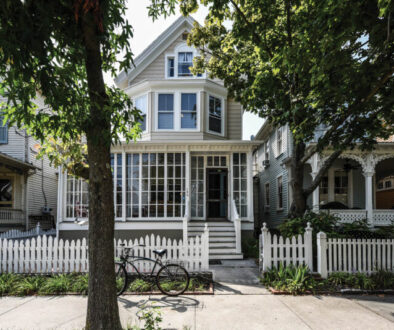Ashes to Ashes
Revisiting the 1962 Ash Wednesday Storm
The U.S. Weather Service New Jersey report on March 5th, 1962, was for a storm with high northeast winds, up to three inches of snow, and tides somewhat higher than normal. But instead, a huge storm unexpectedly hit the Atlantic coast. New Jersey and Cape May County were one of the hardest hit areas when the tempest began on March 6th and raged for a full 60 hours before finally ending. The timing of the storm during the full moon when tides naturally are at their highest, in combination with extremely high winds, pushed the water away from the ocean, across Beach Avenue, onto front lawns and into side streets, creating massive flooding. There was no snow in Cape May, but the storm caused monumental damage throughout the county and all along the Atlantic coast. Many residents were evacuated from their homes due to flooding or loss of utilities. Some areas were so badly flooded that rowboats were needed for evacuations. In Cape May City, widespread flooding resulted from both ocean tides and the overflowing Cape Island Creek to the north. In all, the city weathered a series of five extraordinary high tides over a period of three days. Each high tide produced multiple waves as high as 10 to 15 feet when they hit the shore. Cape May residents were no strangers to nor’easters and had weathered many severe storms, but none of the magnitude of the March Nor’easter that came to be known as the Ash Wednesday Storm.

Fortunately, no lives were lost in the City of Cape May, but only a few beachfront properties were spared massive damage. At the end of the three-day rampage, the Cape May Star and Wave methodically described the damage caused to each property. The first major structure demolished by the storm was Hunt’s Pier, which housed stores such as Bertha Lear’s Yarn and Gift Shop and a soda fountain and candy store operated by the Sagel family. The massive Convention Hall somehow remained standing, but windows, the entire back wall, and the floor were washed away, resulting in damage that would ultimately require demolition. A small portion of the boardwalk in front of Convention Hall stayed intact but the remaining length from its eastern edge all the way to the far western end was broken away from its pilings and the boards hurled across Beach Avenue into properties facing the ocean. As a result, a majority of the damage along the beachfront was caused not only by the high tides and huge waves, but by pieces of the boardwalk and battered buildings that were carried by the violent storm waters into hotels, stores, and homes.
Hotels like the Lafayette, Colonial, and the Admiral, although flooded by the multiple high tides, remained structurally sound, but lost porches and steps. Smaller structures such as homes and commercial establishments did not fare so well. As the water pushed across Beach Avenue along with pieces of demolished boardwalk, volumes of sand were deposited on the street and the front lawns of properties facing the beach. The Hunt Movie Theater, opposite Convention Hall, along with its six attached stores, was badly flooded and covered in sand but protected from severe physical damage by Convention Hall, which stood between it and the ocean and buffered the theater. All in all, most of the buildings on the ocean side of Beach Avenue were structurally ruined, but only Joe Barker’s house at the far eastern end at Wilmington Avenue was actually washed into the ocean.

Residential houses facing the ocean, but on the opposite side of Beach Avenue, had major flooding with up to three or more feet of water on their first floors. Few houses were raised on basements, but if they were, heating and other equipment was damaged. All along the shoreline, water flooded into the streets perpendicular to the beachfront, in some cases, as many as four blocks away from the ocean.
The floods and debris created significant damage to Beach Avenue itself, where parts of the road were washed away and covered with a foot or more of sand. The road was not only impassable but would require extensive repair before any traffic was possible. Due to flooding from Cape Island Creek, the storm also created major damage to some properties along Lafayette Street, where the Golf Club had been located, and on Broad, Bank, and Elmira Streets, as well as in West Cape May. Residents were unprepared for the overflow and severe flooding of the creek at the same time as ocean flooding. Cape Island Creek ran from the harbor on the far eastern side of town across the northern boundary of Cape May City over to West Cape May and south through the South Cape May Meadows. Overflow of creek waters and huge ocean high tides resulted in extensive flooding that almost met in the center of town. Only the most central areas of the town did not flood at some point during the storm.
There are many photos of the storm damage published in local and regional newspapers, but few accounts are reported of the impact of the storm on residents, their homes, and businesses. Local resident Cecilia Love wrote an account of the aftermath of the storm, noting that “we had no warning and so nothing was battened down. The streets are full of garden furniture, for example, which would have been safely stored or fastened down. Because of the strong wind, places were torn apart, and everything floated away. There are refrigerators, mattresses, oil tanks, etc. strewn all over.” She went on to say that “state police were all over. As usual, Cape May was a little late and the motels and stores were looted of salvageable articles before the state police took over.”



Cecilia lived in Frog Hollow, a 12-block area of wetlands that had been filled in to create building lots as Cape May grew in popularity during the 19th century. By 1962, beach erosion was significant all along the Cape May shore due to the construction of the Cold Spring Jetty during WWII as part of creating the Cape May Canal. The beachfront was so eroded and narrow in front of Frog Hollow streets that the area regularly flooded even in severe thunderstorms. During the storm, when electricity was lost, Celia and her twins went to stay with friends, and she worried that the weather would become cold enough to freeze the pipes before the heat could be restored. A day after the storm ended, she noted that while downtown, “Most of the people looked as if they’d slept in their clothes and probably had because there are few people whose heaters were not damaged. I really don’t know how the plumbers and electricians will get around to everyone.”
Although the storm destroyed or severely damaged many residents’ homes, the largest impact was on properties essential to tourism, a majority of which were located on the beachfront. Both the town and individual property owners had less than three months to repair and rebuild for the 1962 summer season. Beachfront hotels such as the Admiral, Colonial, Lafayette, Congress Hall, or Windsor, while not suffering major damage, had to be cleaned, repaired, and prepared for the tourists. Convention Hall was a central focus in the summer season and hosted many events for the entertainment of summer tourists. The damage was so severe that it was not clear if the Hall could even be rebuilt; it certainly would not be possible in time for the 1962 season. Entertainment usually provided at Convention Hall had to be scheduled somewhere else so that the tourists would still have amusements. Cape May’s economic reliance on summer tourists was clear. As little as a week after the storm, local papers no longer reported on storm damage but, instead published stories about progress and what needed to be done to ready the town for the summer season. By mid-April, a little more than a month after the storm, newspapers showed photographs of the repairs to Beach Avenue and hotels along the beachfront.
Towns all along the Atlantic coast needed financial aid to fund the necessary repairs and rebuilding that could not be done without outside assistance. Both the federal and state governments declared the shore a disaster area, freeing up funds and resources to help with the clean-up. The Small Business Administration granted loans and set up field offices all along the shore. Some funds were available to homeowners, but most were restricted for repair and restoration of public buildings. The Red Cross made some funding available for residents throughout Cape May County with awards based on economic need and family circumstances.
Cape May County was fortunate to be represented in the New Jersey Senate by county resident Senator Charles Sandman, who served as the Senate Majority Leader. Senator Sandman clearly understood not only the immediate impact of the storm damage but, more importantly, the long-term economic consequences to his constituents who were almost totally dependent on summer tourism revenue. Immediately after the storm, he supported communities by having state equipment brought in to supplement the limited heavy equipment available in these small communities, speeding up the removal of sand and debris from streets and lawns. Sandman repeatedly suggested that 80% of the County’s economy was based on tourism and proposed that major funds needed to be made immediately available to prepare the resorts for the 1962 Memorial Day weekend, the start of the summer season for resort communities all along the Jersey shore. His priority was for state and federal funds to be spent to repair roads such as Beach Avenue in Cape May so that vacationers would be able to travel. After roads were restored, projects to protect the beachfront and the beaches would be undertaken. The city successfully used federal and state dollars available in the years following the storm not only to address its damage but to revive the resort industry and bolster future tourism.
Although initial efforts targeted the immediate post-storm cleanup needs and costs of rebuilding, other initiatives were designed to position Cape May for the future and protect the town from possible damage from future storms. The storm called attention to many of the issues the city was facing in 1962 including the negative impact from the city’s decreasing and changing year-round and summer populations. Even before the storm, a large percent of residents were over 65 years of age. Homes and businesses were described as run-down or in need of repair. Some living conditions were reported as “slum like.” Beach erosion had been an issue for years, reducing the once-wide beaches into narrow strips of sand.

The Cape May County Planning Board met one week after the storm to urge local planning boards to meet as soon as possible to adopt rules to ensure positive future development. A number of ideas were suggested to prevent the negative impact of future storms and flooding. One suggestion was for local communities to review vacant land for the possibility of future storm flooding and consider using programs such as New Jersey Green Acres to purchase land and protect it from future development. Another idea was to purchase vulnerable properties, primarily those that had withstood significant damage in the present storm, and demolish them, creating open land that would be zoned as not buildable to mitigate the possibility of damage from future storms. Current residents would be located to other comparable properties away from areas of potential flooding. A final suggestion had to do with elevations. The County Board noted that the storm “forcefully demonstrated the danger of development in low lying sections,” noting that the extent of damage to properties not fronting on the beachfront was directly related to the elevation at which they were built. The board recommended that local officials raise the requirements for elevation levels, particularly for properties in vulnerable areas.
The City of Cape May distributed a 1962 Annual Report to residents describing tax figures and reporting major events of 1962, stating: “This year 1962 will be remembered in the history of Cape May. The devastating blow of the March storm was a blessing in disguise… the entire population of this historic resort gathered together and mustered the strength, the know-how, and the funds to build a bigger and better future.” Mayor Walter Wright, Jr. noted that Cape May had been “knocked down, but not out! In a matter of days, most people were back in their own homes; in a matter of weeks all debris had been cleared away. Now we have one of the best-protected beachfronts in the country.”






Laurice Albed grew up in one of the Stockton Cottages, purchased by her father, Samuel Albed, in the 1930s. Her father owned a successful rug company on the promenade until the Ash Wednesday storm. He did not rebuild, instead opening another location in Wayne, Pennsylvania. Their home here became a summer place, which Laurice still visits each year. Learn more about her in “Family Ties“
The city was the first to receive state approval for a number of projects, including construction of the new seawall and promenade which would be completed in 1963. Decisions about the seawall and promenade were not made without consideration of the tourism economy. Cape May summer visitors had enjoyed the boardwalk for more than a century, but government officials and citizens understood the importance of protecting properties from future storms. The seawall provided that protection, and the promenade replaced earlier boardwalks, although the fundamental issue of beach erosion would not be addressed through replenishment efforts until almost 30 years after the storm.
Long before the storm and as early as 1950, Cape May residents were beginning to consider the historic value of many of the older properties in town. In 1954, the Cape May Women’s Community Club began a project to place date plaques on houses to mark their historical importance. This focus on history gained wide momentum following the storm and throughout 1962. The significant damage and the need to repair so many properties forced both residents and business owners to consider restoration. In March, just after the storm hit, the city formed an Architectural Advisory Committee to the Planning Board to consider the ways in which properties were rehabilitated and in May established the Historical Celebration Committee. In June, the Chamber of Commerce identified 36 historic properties which were then featured in a four-page supplement to the Star and Wave newspaper designed to showcase history and preservation. The supplement included a location map with short histories of each property provided by the Historical Celebration Committee. These 36 properties became the nucleus of a Historic Zone established by the Cape May Planning Board and endorsed by City Council in August 1962.
The infamous Ash Wednesday Storm created excessive damage, necessitated months of repair and rebuilding, but established the roots of a preservation movement that would rescue and establish tourism for years to come. ■



